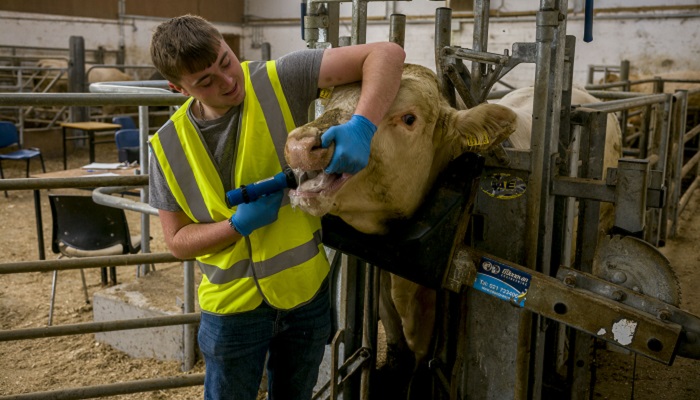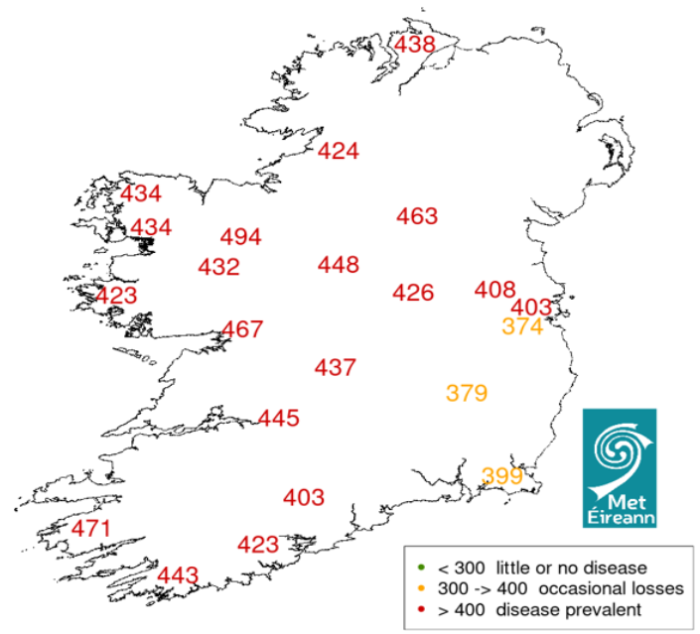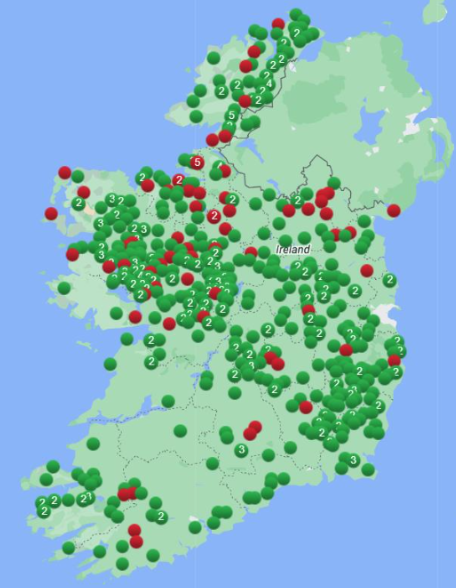14 November 2023
Vigilance required as liver fluke prevalent across many areas

Livestock owners have been urged to be vigilant for liver fluke infestations of cattle and sheep following the publication of this year’s Liver Fluke Forecast by the Department of Agriculture, Food and the Marine.
Each year, the Department of Agriculture, Food and the Marine (DAFM), in collaboration with Met Éireann, UCD, Teagasc and Animal Health Ireland, advises farmers of the predicted risk of disease caused by liver fluke infection in livestock for that winter. This year’s forecast is based on meteorological data gathered between May and October 2023 by Met Éireann.
The Ollerenshaw Summer Index 2023 (Figure 1) predicts infection being prevalent across all areas of Ireland, with the exception of south Leinster where the risk of disease is somewhat lower. The high values of the index are due to the warm, wet conditions experienced in July, August, September and October.
Figure 1. Ollerenshaw Summer Index values 2023, and the risk of disease due to liver fluke

Liver fluke in cattle
Although the prevalence of liver fluke is high, given the weather conditions experienced this summer, the Beef HealthCheck programme – run in partnership with Meat Industry Ireland – has reported that this year’s levels of liver fluke infection are slightly lower than those reported in the last few years.
This programme collects and reports liver fluke information in cattle at slaughter from participating meat factories nationwide. To date, abattoir examinations showed an average of 39% of herds with at least one animal with liver damage due to liver fluke and live liver fluke parasites were seen in 12% of herds.
Counties in the northwest of Ireland were more heavily affected, with 70-80% of herds in Sligo, Roscommon and Donegal reported to have signs of liver fluke at slaughter. The prevalence within herds is typically low depending on the farm with 6.6% of animals presented to slaughter showing signs of liver fluke damage and 1.1% of animals showing live liver fluke parasites.
It is important for farmers to know whether liver fluke is present on their farm and to treat accordingly to avoid production losses. The Beef HealthCheck reports can be a useful tool to understand liver fluke on-farm and are available to farmers on the ICBF website for those who have slaughtered animals at a participating factory since 2016.
Liver fluke in sheep
From June to December, DAFM collects blood samples from lambs in meat factories from a proportion of flocks at the time of slaughter. These are tested for the presence of liver fluke antibodies to determine the timing and geographical spread of liver fluke exposure in grazing lambs.
The number of flocks selected for sampling from each county is generally proportionate to the sheep population of that county over the entire sampling period. A number of samples are taken from each selected flock and these are pooled at laboratory level. The presence of liver fluke antibodies in 2023 born lambs is therefore a sentinel for exposure to liver fluke in the wider sheep population in the region, as by definition these lambs must have been exposed during the 2023 grazing season.
From July to October 2023, blood samples from 757 flocks across 26 counties were tested for the presence of liver fluke antibodies (Table 1 and Figure 2).
Table 1: 2023 Survey of the Prevalence of liver fluke infection in Irish sheep flocks
| Month | Number of flocks tested | Number ELISA Positive | Positive (%) |
|---|---|---|---|
| July | 268 | 16 | 6 |
| August | 176 | 25 | 14.2 |
| September | 179 | 51 | 28.5 |
| October | 134 | 19 | 14 |
Data from this survey indicates that the majority of infected flocks reside in counties in the west. Some positive and inconclusive results were reported in counties outside of the west and the northwest in the August testing, possibly associated with a high summer rainfall level. This was the case in the border areas, midlands, south and in Leinster where there was substantial evidence of fluke exposure in lambs by October.
Figure 2. Liver Fluke Abattoir ELISA Survey Results From July to October 2023

Please note: Green dots represent seronegative flocks and red dots represent seropositive flocks. Points have been moved slightly to preserve anonymity of flock owners. Numbers in circles indicate more than one flock sampled within that specific area.
Farm-to-farm variation
In order to assess the risk of liver fluke disease on any particular farm, DAFM has noted that various environmental factors, particularly climate, landform and soil type (especially whether soils are heavy or free draining) must be taken into account. This is because the intermediate host of the parasite, which is a mud snail, occurs in soil that is slightly acidic and muddy. Thus, areas with rushes or wet patches (e.g., around gates, troughs) are particularly important with regard to liver fluke risk as they can help to maintain a population of the infective stage of the parasite. In addition, livestock owners should factor in prior liver fluke history on the farm as this is an important indicator of future disease risks.
For more information on the Liver Fluke Forecast, click here.
Also read: The successful control of liver fluke
